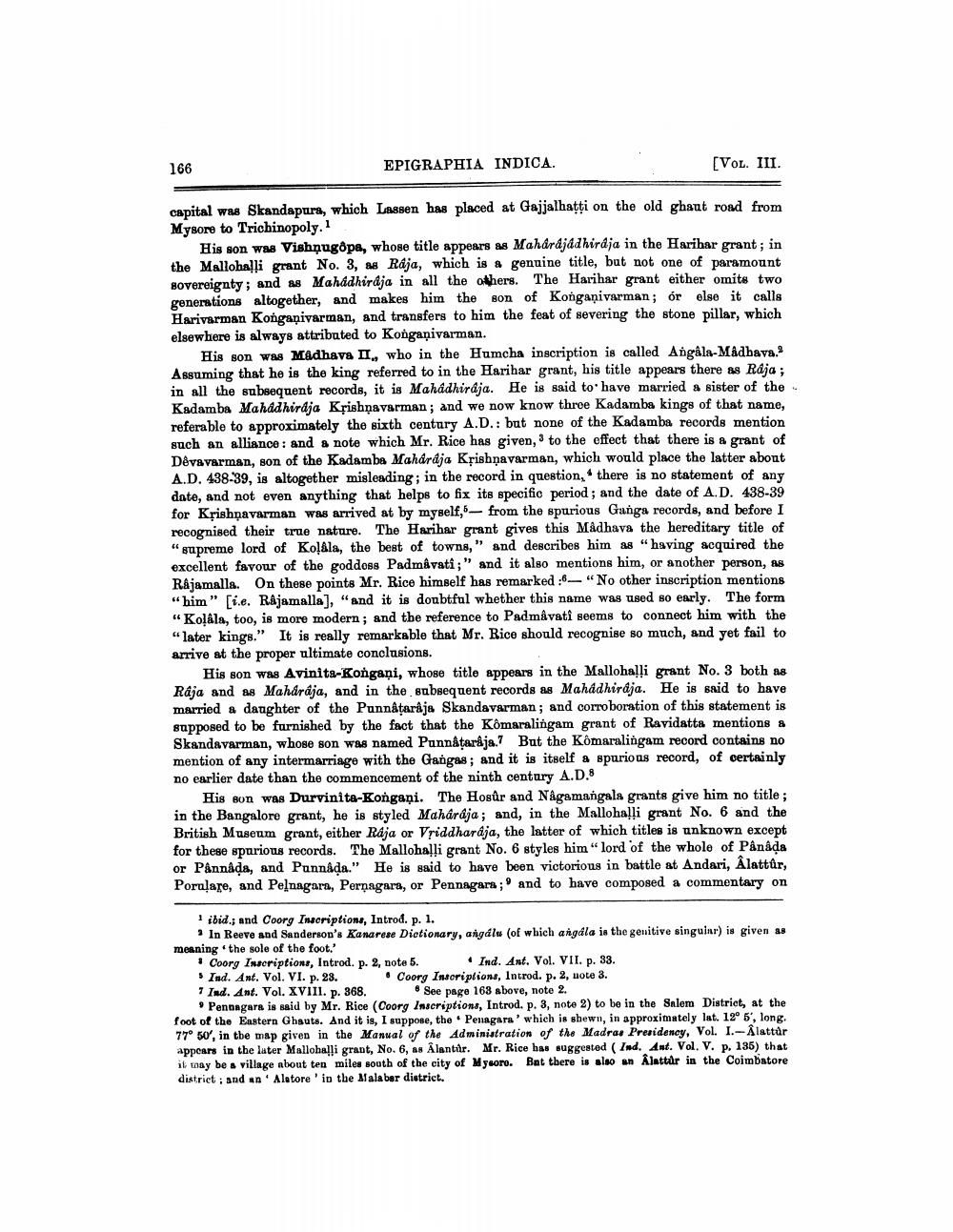________________
166
EPIGRAPHIA INDICA.
[VOL. III.
capital was Skandapura, which Lassen has placed at Gajjalhatti on the old ghant road from Mysore to Trichinopoly. .
His son was Vishnugôpa, whose title appears as Mahardjadhirdja in the Harihar grant; in the Mallohalli grant No. 3, a Raja, which is a genuine title, but not one of paramount sovereignty, and as Mahadhiraja in all the others. The Harihar grant either omits two generations altogether, and makes him the son of Kongaộivarman; or else it calls Harivarman Konganivarman, and transfers to him the feat of severing the stone pillar, which elsewhere is always attributed to Konganivarman.
His son was Madhava II, who in the Humcha inscription is called Angala-Madhava. Assuming that he is the king referred to in the Harihar grant, his title appears there as Raja; in all the subsequent records, it is Mahadhiraja. He is said to have married a sister of the Kadamba Mahadhiraja Krishṇavarman; and we now know three Kadamba kings of that name, referable to approximately the sixth century A.D.: but none of the Kadamba records mention such an alliance : and a note which Mr. Rice has given, to the effect that there is a grant of Dévavarman, son of the Kadamba Mahardja Krishnavarman, which would place the latter about A.D. 438-39, is altogether misleading; in the record in question, there is no statement of any date, and not even anything that helps to fix its specific period; and the date of A.D. 438-39 for Krishnavarman was arrived at by myself, 5 - from the spurious Ganga records, and before I recognised their true nature. The Harihar grant gives this Madhava the hereditary title of “supreme lord of Koļ&la, the best of towns,” and describes him as “having acquired the excellent favour of the goddess Padmavati;" and it also mentions him, or another person, as Rajamalla. On these points Mr. Rice himself has remarked :6- "No other inscription mentions “him" [ie. Rajamalla], "and it is donbtful whether this name was used so early. The form “Kołála, too, is more modern ; and the reference to Padmavati seems to connect him with the "later kings." It is really remarkable that Mr. Rice should recognise so much, and yet fail to arrive at the proper ultimate conclusions.
His son was Avinita-Kongani, whose title appears in the Mallohalli grant No. 3 both as Raja and as Maharaja, and in the subsequent records as Mahadhiraja. He is said to have married a daughter of the Pannåtarija Skandavarman; and corroboration of this statement is supposed to be furnished by the fact that the Kömaralingam grant of Ravidatta mentions & Skandavarman, whose son was named Pannataraja.7 But the Kömaralingam record contains no mention of any intermarriage with the Gangas; and it is itself a spurions record, of certainly no earlier date than the commencement of the ninth century A.D.8
His son was Durvinita-Kongani. The Hosûr and Nagamangala grants give him no title; in the Bangalore grant, he is styled Maharaja ; and, in the Mallohalli grant No. 6 and the British Museum grant, either Raja or Vriddharaja, the latter of which titles is unknown except for these spurious records. The Mallohalli grant No. 6 styles him " lord of the whole of Panada or Pannada, and Punnada." He is said to have been victorious in battle at Andari, Alattur, Porulare, and Pelnagara, Pernagara, or Pennagars; and to have composed a commentary on
ibid.; and Coorg Inscriptions, Introd. p. 1.
• In Reeve and Sanderson's Kanarese Dictionary, angáls (of which angala is the genitive singuiar) is given as meaning the sole of the foot.' • Coorg Inscriptions, Introd. p. 2, note 5.
Ind. Ant. Vol. VII. p. 33. Ind. Ant. Vol. VI. p. 28. • Coorg Inscriptions, Introd. p. 2, uote 3. 7 Ind. Ant. Vol. XVIII. p. 368.
See page 168 sbove, note 2. Pennagars is said by Mr. Rice (Coorg Inscriptions, Introd. p. 3, note 2) to be in the Salem District, at the foot of the Eastern Ghauts. And it is, I suppose, the . Penagara' which is shewn, in approximately lat. 12° 5, long. 77° 50', in the map given in the Manual of the Administration of the Madras Presidency, Vol. I.-Alattar appears in the later Mallohalli grant, No. 6, as Alantur. Mr. Rice has suggested (Ind. Ant. Vol. V. p. 135) that
a miles south of the city of Mycoro. But there is also an Alattår in the Coimbatore district; and an Alatore in the Malaber district.




